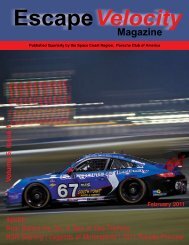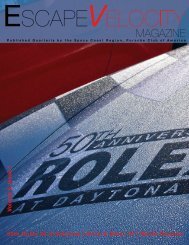7TEGI 'SEWX 6IKMSR - Space Coast PCA Home Page - Porsche ...
7TEGI 'SEWX 6IKMSR - Space Coast PCA Home Page - Porsche ...
7TEGI 'SEWX 6IKMSR - Space Coast PCA Home Page - Porsche ...
Create successful ePaper yourself
Turn your PDF publications into a flip-book with our unique Google optimized e-Paper software.
Revealing the Mystery<br />
of <strong>Porsche</strong> History<br />
By Ralph Fritsche<br />
Ferdinand <strong>Porsche</strong> was a prolific automotive engineer, but many<br />
people are not aware of the extent of his influence on automotive<br />
history. His legacy lies, not only in the cars that bear his name, but<br />
also on the history of companies that today would be considered<br />
both competitors and collaborators.<br />
This story illustrates just such an example. The year was 1931 and<br />
Ferdinand <strong>Porsche</strong> was still struggling with the economic affects<br />
of the great depression; however, in April of that year<br />
he and Adolf Rosenberg founded an automotive consulting<br />
firm in Stuttgart. The pair brought together<br />
several old coworkers, who would continue to play a<br />
leading role in <strong>Porsche</strong>s future. They included Karl<br />
Rabe, Erwin Komenda and <strong>Porsche</strong>’s son Ferry.<br />
The <strong>Porsche</strong> consulting firm worked on many projects<br />
and business steadily grew. Then in 1932 <strong>Porsche</strong><br />
founded a subsidiary company in order to develop a<br />
racing car, although at this point a customer for the<br />
project hadn’t been found. The P-Wagen project (P<br />
for <strong>Porsche</strong>) was designed to be a Grand Prix racer<br />
according to the current regulations of the 750 kg<br />
formula.<br />
In 1932 the struggling German automobile manufacturers<br />
Audi, DKW, Horch, and Wanderer joined forces to form<br />
Auto Union in an attempt to gain a better market position at the<br />
expense of Mercedes-Benz. The Auto Union chairman of the board<br />
was in search of a showpiece project and at Adolf Rosenberg’s insistence<br />
he met with <strong>Porsche</strong> who had worked for him before. Then<br />
at the 1933 Berlin Motor Show, the new German Chancellor Adolf<br />
Hitler announced two programs intended to demonstrate Germany’s<br />
growing engineering prowess to the world. The first was the<br />
People’s car project (of which <strong>Porsche</strong>’s involvement is well known)<br />
and the other was a state-sponsored motor racing program initially<br />
intended to provide Mercedes-Benz the opportunity to develop a<br />
high-speed automotive industry.<br />
Auto Union and <strong>Porsche</strong>, sensing an opportunity, arranged for a<br />
meeting with Hitler at the Reich Chancellery to plead the case that<br />
for the good of Germany it would be better for two companies to<br />
develop the project. Much to the dismay of Mercedes, Hitler agreed<br />
to split the seed money between both Auto Union and Mercedes-Benz.<br />
12 volume 4, Issue 1<br />
Paddock at the AVUS race, 1937, start number 31, Bernd Rosemeyer’s car. To<br />
the right of it, one of the two single-seater race cars which started in this race for<br />
Auto Union alongside the two streamlined cars.<br />
With an agreement in place, Auto Union purchased the <strong>Porsche</strong><br />
subsidiary and along with it the P-Wagen project. The motor racing<br />
program proved to be a huge success and the Silver Arrows from<br />
both Auto Union and Mercedes-Benz dominated Grand Prix racing<br />
until the start of World War II.<br />
The <strong>Porsche</strong>/Auto Union Grand Prix car typified the <strong>Porsche</strong><br />
philosophy of unconventional design. Even thought the weight of<br />
the car was restricted to 750 kg, <strong>Porsche</strong> opted for a mid mounted<br />
16-cylinder engine. Light alloys were used in both the block and<br />
the head in order to keep weight down. In its initial versions the<br />
supercharged engine displaced just under 4.4 liters and produced<br />
295 bhp, which drove the rear wheels via a five-speed gearbox.<br />
The final evolution of the original <strong>Porsche</strong> P-Wagen design was<br />
the Auto Union Streamliner. Although evolved from the original





